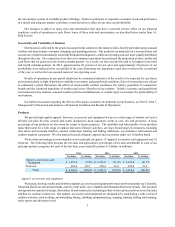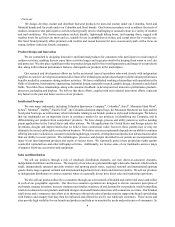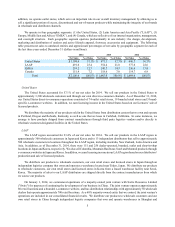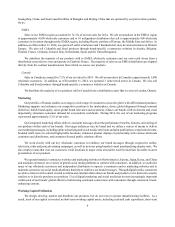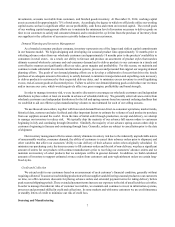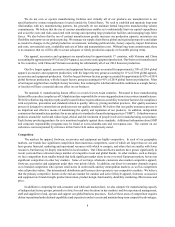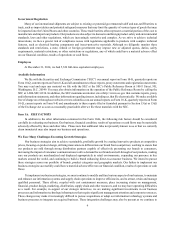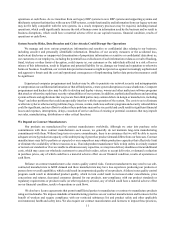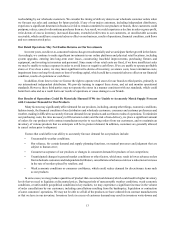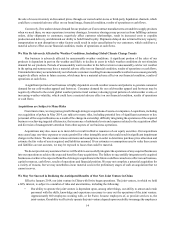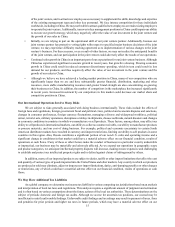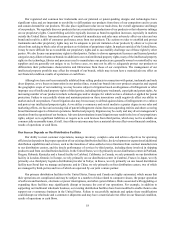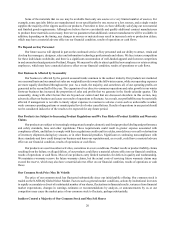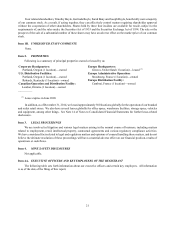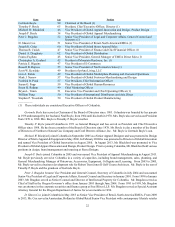Columbia Sportswear 2014 Annual Report Download - page 17
Download and view the complete annual report
Please find page 17 of the 2014 Columbia Sportswear annual report below. You can navigate through the pages in the report by either clicking on the pages listed below, or by using the keyword search tool below to find specific information within the annual report.13
rescheduling by our wholesale customers. We consider the timing of delivery dates in our wholesale customer orders when
we forecast our sales and earnings for future periods. If any of our major customers, including independent distributors,
experience a significant downturn in business or fail to remain committed to our products or brands, these customers could
postpone, reduce, cancel or discontinue purchases from us. As a result, we could experience a decline in sales or gross profit,
write-downs of excess inventory, increased discounts, extended credit terms to our customers, or uncollectable accounts
receivable, which could have a material adverse effect on our business, results of operations, financial condition, cash flows
and our common stock price.
Our Retail Operations May Not Realize Returns on Our Investments
In recent years, our direct-to-consumer business has grown substantially and we anticipate further growth in the future.
Accordingly, we continue to make significant investments in our online platforms and physical retail locations, including
system upgrades, entering into long-term store leases, constructing leasehold improvements, purchasing fixtures and
equipment, and investing in inventory and personnel. Since many of our retail costs are fixed, if we have insufficient sales
we may be unable to reduce expenses in order to avoid losses or negative cash flows. If we are unable to operate profitable
stores or if we close a store, we may incur significant write-downs of inventory, severance costs, lease termination costs,
impairment losses on long-lived assets or loss of working capital, which could have a material adverse effect on our financial
condition, results of operations or cash flows.
In addition, from time to time we license the right to operate retail stores for our brands to third parties, primarily to
our international independent distributors. We provide training to support these stores, and set and monitor operational
standards. However, these third parties may not operate the stores in a manner consistent with our standards, which could
harm their sales and as a result harm our results of operations or cause damage to our brands.
Our Results of Operations Could Be Materially Harmed If We Are Unable to Accurately Match Supply Forecast
with Consumer Demand for Our Products
Many factors may significantly affect demand for our products, including, among other things, economic conditions,
fashion trends, the financial condition of our distributors and wholesale customers, consumer and customer preferences and
weather, making it difficult to accurately forecast demand for our products and our future results of operations. To minimize
our purchasing costs, the time necessary to fill customer orders and the risk of non-delivery, we place a significant amount
of orders for our products with contract manufacturers prior to receiving orders from our customers, and we maintain an
inventory of various products that we anticipate will be in greatest demand. In addition, customers are generally allowed
to cancel orders prior to shipment.
Factors that could affect our ability to accurately forecast demand for our products include:
• Unseasonable weather conditions;
• Our reliance, for certain demand and supply planning functions, on manual processes and judgment that are
subject to human error;
• Consumer acceptance of our products or changes in consumer demand for products of our competitors;
• Unanticipated changes in general market conditions or other factors, which may result in lower advance orders
from wholesale customers and independent distributors, cancellations of advance orders or a reduction or increase
in the rate of reorders placed by retailers; and
• Weak economic conditions or consumer confidence, which could reduce demand for discretionary items such
as our products.
In some cases, we may produce quantities of product that exceed actual demand, which could result in higher inventory
levels that we need to liquidate at discounted prices. During periods of unseasonable weather conditions, weak economic
conditions, or unfavorable geopolitical conditions in key markets, we may experience a significant increase in the volume
of order cancellations by our customers, including cancellations resulting from the bankruptcy, liquidation or contraction
of some customers’ operations. We may not be able to sell all of the products we have ordered from contract manufacturers
or that we have in our inventory. Inventory levels in excess of customer demand may result in inventory write-downs and


